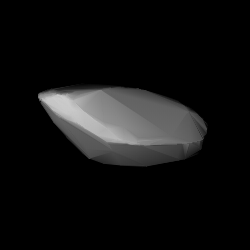| (1677) Tycho Brahe | ||
|---|---|---|
 | ||
| Descubrimiento | ||
| Descubridor | Yrjö Väisälä | |
| Fecha | 6 de septiembre de 1940 | |
| Lugar | Turku | |
| Designaciones | 1940 RO, 1928 SP, 1935 FL, 1952 QN1, 1952 SD1, A916 UA | |
| Nombre provisional | 1940 RO | |
| Categoría | Cinturón de asteroides | |
| Orbita a | Sol | |
| Elementos orbitales | ||
| Longitud del nodo ascendente | 337,9° | |
| Inclinación | 14,85° | |
| Argumento del periastro | 317,7° | |
| Semieje mayor | 2,534 ua | |
| Excentricidad | 0,1068 | |
| Anomalía media | 197,5° | |
| Elementos orbitales derivados | ||
| Época | 2457000.5 (2014-Dec-09.0) TDB[1] | |
| Periastro o perihelio | 2,263 ua | |
| Apoastro o afelio | 2,804 ua | |
| Período orbital sideral | 1473 días | |
| Características físicas | ||
| Periodo de rotación | 3,89 horas | |
| Magnitud absoluta | 11.7 y 11.73 | |
| Cuerpo celeste | ||
| Anterior | (1676) Kariba | |
| Siguiente | (1678) Hveen | |
(1677) Tycho Brahe es un asteroide que forma parte del cinturón de asteroides y fue descubierto por Yrjö Väisälä el 6 de septiembre de 1940 desde el observatorio de Iso-Heikkilä, Finlandia.
YouTube Encyclopedic
-
1/3Views:1 6932 9561 836
-
Video of Super Nova Nebulae Galaxies Space Shuttle
-
Cell Structure & Function - Science With Tom #2
-
Astronomy 101: Geocentric Models
Transcription
Designación y nombre
Tycho Brahe recibió al principio la designación de 1940 RO. Posteriormente se nombró en honor del astrónommo danés Tycho Brahe (1546-1601).[2]
Características orbitales
Tycho Brahe está situado a una distancia media del Sol de 2,534 ua, pudiendo alejarse hasta 2,804 ua. Tiene una excentricidad de 0,1068 y una inclinación orbital de 14,85°. Emplea en completar una órbita alrededor del Sol 1473 días.
Véase también
Referencias
- ↑ «Datos de la NASA (JPL Small-Body Database Browser)». Consultado el 22 de junio de 2015.
- ↑ Schmadel, Lutz D. (2003). Dictionary of Minor Planet Names (en inglés) (5ª edición). Springer. ISBN 3-540-00238-3.
Enlaces externos
- «(1677) Tycho Brahe» (en inglés). Minor Planet Center. Consultado el 22 de junio de 2015.
